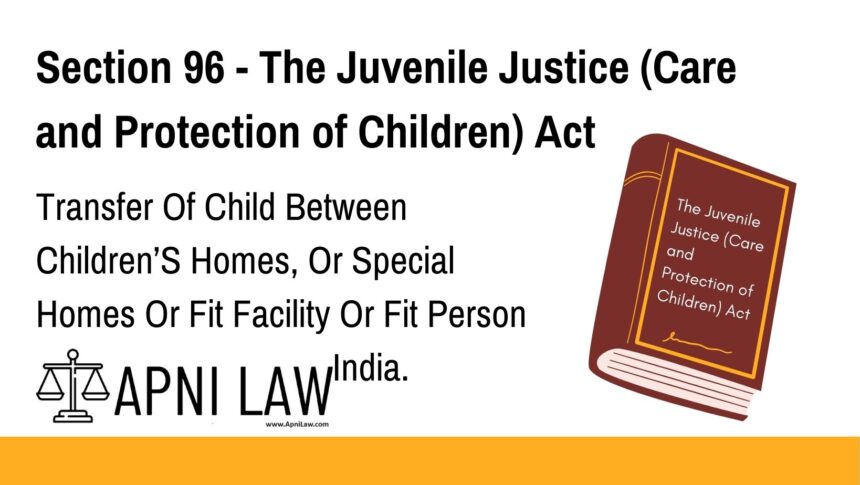Code: Section 96 of the Juvenile Justice (Care and Protection of Children) Act, 2015
(1) The State Government may at any time, on the recommendation of a Committee or Board, as the case may be, notwithstanding anything contained in this Act, and keeping the best interest of the child in mind, order the child’s transfer from any Children’s Home or special home or fit facility or fit person, to a home or facility, within the State with prior intimation to the concerned Committee or the Board:
Provided that for transfer of a child between similar home or facility or person within the same district, the Committee or Board, as the case may be, of the said district shall be competent to issue such an order.
(2) If transfer is being ordered by a State Government to an institution outside the State, this shall be done only in consultation with the concerned State Government.
(3) The total period of stay of the child in a Children’s Home or a special home shall not be increased by such transfer.
(4) Orders passed under sub-sections (1) and (2) shall be deemed to be operative for the Committee or the Board, as the case may be, of the area to which the child is sent.
Explanation of Section 96 JJ Act
Section 96 of the Juvenile Justice (Care and Protection of Children) Act, 2015 governs the transfer of children between child care institutions, such as Children’s Homes or Special Homes, or to/from fit persons or fit facilities. This provision ensures such transfers are made with the child’s best interest in mind and do not result in unjustified extensions of institutionalization.
Key Highlights:
- Transfer within the state requires prior intimation to the respective Juvenile Justice Committee or Board.
- Transfer within the same district can be approved and ordered directly by the local Committee or Board.
- Inter-state transfers can only happen in consultation with the government of the receiving state.
- The child’s total period of stay in care institutions cannot be extended due to a transfer.
- After transfer, the Committee or Board in the new location assumes full legal jurisdiction.
Illustration
Example 1: Intra-State Transfer of a Child
A child living in a Children’s Home in City A requires better educational opportunities. On recommendation by the Child Welfare Committee, the State Government transfers the child to a more suitable Children’s Home in City B. The Committee in City B is informed and takes jurisdiction.
Example 2: Inter-State Transfer
A child originally from State X is currently placed in a Special Home in State Y. Upon recommendation, State Y seeks consent from State X and transfers the child to a facility closer to their home. The legal responsibility now lies with the Committee in the receiving area in State X.
Common Questions and Answers on Section 96 JJ Act
1. Who can initiate the transfer of a child under Section 96?
The transfer is initiated by the State Government based on the recommendation of the Juvenile Justice Board or Child Welfare Committee.
2. Can a child be transferred to another district within the same state without State Government involvement?
Yes, if the transfer is within the same district, the local Board or Committee can issue the order independently.
3. Does the child’s length of stay in institutional care reset due to transfer?
No. As per Section 96(3), the child’s period of stay remains unaffected by the transfer.
4. Can a child be transferred to another state?
Yes, but only after consultation with the government of the receiving state as per Section 96(2).
5. Who becomes responsible for the child after transfer?
The Board or Committee in the new location assumes responsibility for the child after the transfer becomes operative.
Conclusion
Section 96 of the Juvenile Justice (Care and Protection of Children) Act, 2015 ensures that transfers of children between institutions are made thoughtfully, lawfully, and in the best interest of the child. It provides necessary checks to prevent misuse and protects children’s rights during the transfer process.
For detailed legal insights and expert commentary on child protection and juvenile justice, visit ApniLaw.








